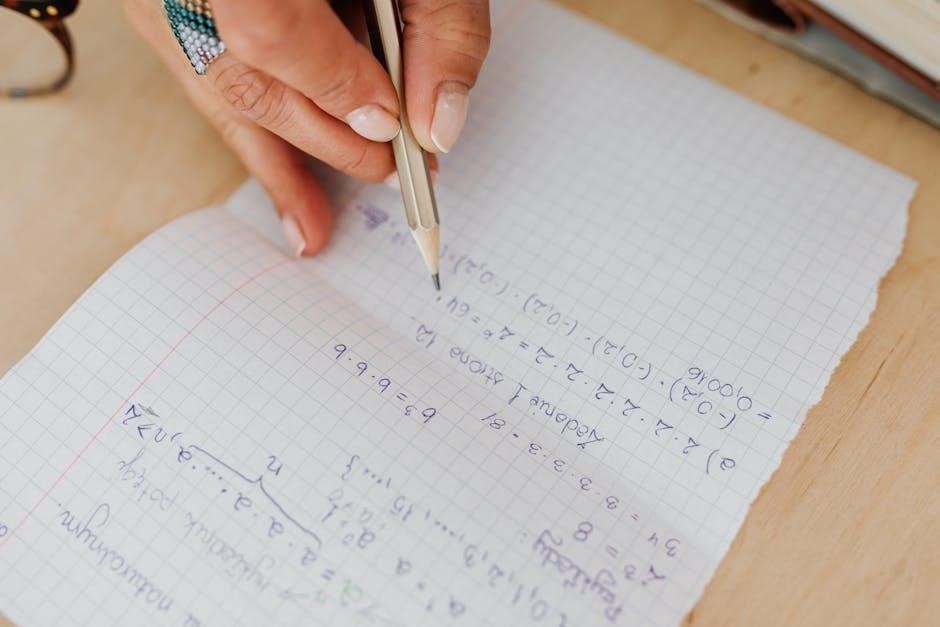Two-step equations involve solving for a variable using two operations‚ typically combining multiplication/division and addition/subtraction․ They are fundamental in algebra‚ requiring sequential steps to isolate the variable․ These equations are widely used in real-world problems‚ such as budgeting or engineering․ Mastering them builds a strong foundation for advanced mathematical concepts․ Various resources‚ including PDF guides and online tools‚ provide practice opportunities to enhance problem-solving skills․
Definition and Importance
A two-step equation is an algebraic equation requiring two operations to solve for the variable․ It typically involves a combination of addition/subtraction and multiplication/division․ These equations are essential in algebra as they introduce foundational problem-solving skills․ Understanding two-step equations is crucial for progressing to more complex math‚ such as quadratic equations and real-world applications like budgeting‚ engineering‚ and physics․ They enhance logical thinking and mathematical reasoning․ Resources like PDF guides and online tools offer extensive practice‚ making them a vital part of algebraic learning․ Mastering two-step equations builds confidence and prepares students for advanced mathematical challenges․
Real-World Applications
Two-step equations are invaluable in real-world scenarios‚ providing practical solutions to everyday problems․ For instance‚ they are used in budgeting to balance income and expenses‚ ensuring financial stability․ In engineering and physics‚ these equations help calculate forces‚ velocities‚ and distances‚ essential for designing structures and understanding motion․ They are also applied in cooking to adjust ingredient quantities and in music to determine tempo changes; Additionally‚ two-step equations aid in medical dosage calculations‚ ensuring accurate administration of medications․ These applications highlight their relevance beyond academics‚ demonstrating how they simplify complex tasks and enhance problem-solving skills․ Mastering two-step equations equips individuals to tackle real-world challenges effectively‚ making them a cornerstone of practical mathematics․

Understanding the Structure of Two-Step Equations
Two-step equations require reversing two operations in sequence‚ such as multiplication followed by addition․ The goal is to isolate the variable by applying inverse operations strategically․
Identifying Operations in the Equation
Identifying operations in a two-step equation is crucial for solving it correctly․ Start by examining the equation to determine the order of operations applied to the variable․ Typically‚ equations involve a combination of addition/subtraction and multiplication/division․ For example‚ in the equation 3y + 6 = 12‚ the operations are addition and multiplication․ The first step is to reverse the addition by subtracting 6 from both sides․ Next‚ undo the multiplication by dividing both sides by 3 to isolate y․ Always work in the reverse order of operations to isolate the variable effectively․ This systematic approach ensures accuracy and simplifies the solving process for any two-step equation․
Distinguishing Between Constants and Coefficients
In two-step equations‚ identifying constants and coefficients is essential for accurate solutions․ A constant is a numerical value without a variable‚ such as 6 in 3y + 6 = 12․ A coefficient‚ like 3 in the same equation‚ multiplies the variable․ Correctly distinguishing them ensures proper application of inverse operations․ For instance‚ in 10 + 3v = 25‚ 10 is the constant‚ and 3 is the coefficient․ Always address constants first by subtraction or addition‚ then handle coefficients through division or multiplication․ This distinction is crucial for maintaining the equation’s balance and isolating the variable effectively․ Misidentifying these elements can lead to incorrect solutions‚ emphasizing the importance of careful analysis before solving․

Step-by-Step Guide to Solving Two-Step Equations
To solve two-step equations‚ first undo addition or subtraction to isolate terms with variables․ Next‚ undo multiplication or division to solve for the variable․ Apply inverse operations sequentially to maintain balance‚ ensuring accurate solutions in each step․ This structured approach simplifies complex equations‚ making them easier to solve systematically․
Step 1: Undo Addition or Subtraction
The first step in solving two-step equations is to eliminate any addition or subtraction by applying the inverse operation․ For example‚ if the equation is (3y + 6 = 12)‚ subtract 6 from both sides to isolate the term with the variable․ This step ensures that the variable term is separated from constants‚ simplifying the equation for further solving․ Always remember to perform the same operation on both sides to maintain balance․ This foundational step is crucial for accurately solving the equation in subsequent steps․ Proper execution here sets the stage for correctly undoing multiplication or division next․
Step 2: Undo Multiplication or Division
After isolating the variable term‚ the next step is to eliminate any multiplication or division by applying the inverse operation․ For instance‚ if the equation is now (3y = 18)‚ divide both sides by 3 to solve for y‚ resulting in y = 6․ This step is crucial as it isolates the variable completely․ Always ensure the operation is applied to both sides to maintain equality․ If the equation involves division‚ use multiplication‚ and vice versa․ Carefully performing this step ensures the variable is solved accurately․ This process completes the two-step equation-solving method‚ leading to the correct solution for the variable․
Checking the Solution
After solving the equation‚ it is essential to check the solution by substituting the value back into the original equation․ This step ensures that both sides of the equation are equal‚ confirming the correctness of the solution․ For example‚ if the equation was (3y + 6 = 12) and you found (y = 2)‚ substituting (y = 2) into the original equation gives (3(2) + 6 = 12)‚ which simplifies to (6 + 6 = 12)‚ proving the solution is correct․ This verification process helps identify any errors made during the solving steps and builds confidence in the answer․ Always check your solution to ensure accuracy and completeness․

Common Mistakes in Solving Two-Step Equations
Common errors include forgetting to reverse operations‚ applying incorrect order of operations‚ and mishandling negative coefficients or fractions․ These mistakes can lead to incorrect solutions․
Forgetting to Reverse Operations
One of the most frequent mistakes when solving two-step equations is forgetting to reverse the order of operations․ Unlike one-step equations‚ two-step equations require undoing operations in the reverse order they appear․ For example‚ in an equation like 3y + 6 = 12‚ students often forget to subtract 6 before dividing by 3․ This oversight leads to incorrect solutions․ Similarly‚ in equations involving negative coefficients‚ such as 10 ‒ 3v = 25‚ forgetting to reverse the subtraction and division steps can result in errors․ It is essential to methodically reverse each operation to isolate the variable correctly․ Always start by undoing addition or subtraction before addressing multiplication or division to avoid this common pitfall․
Incorrect Order of Operations
A common mistake when solving two-step equations is performing operations in the wrong order․ For instance‚ in an equation like 3y + 6 = 12‚ some students might divide by 3 before subtracting 6‚ leading to an incorrect solution․ Similarly‚ in equations involving negative coefficients‚ such as 10 ‒ 3v = 25‚ misapplying the order of operations can result in sign errors․ It is crucial to follow the reverse order of operations: first undo addition or subtraction‚ then address multiplication or division․ Neglecting this sequence can lead to confusion and incorrect answers․ Always double-check your steps to ensure operations are performed in the correct order‚ especially when dealing with negative numbers or complex coefficients․

Two-Step Equations Involving Integers
Two-step equations with integers require careful handling of positive and negative numbers․ Solving them involves reversing operations in the correct sequence to isolate the variable effectively․
Examples with Positive Integers
Solving two-step equations with positive integers involves isolating the variable through sequential operations․ For instance‚ consider the equation (3y + 6 = 12)․ First‚ subtract 6 from both sides to get (3y = 6)‚ then divide by 3 to find (y = 2)․ Another example is (10 ‒ 3v = 25)․ Subtract 10 from both sides to get (-3v = 15)‚ then divide by (-3) to find (v = -5)․ These examples demonstrate how to apply inverse operations to isolate the variable․ Positive integers simplify the process‚ allowing focus on the method without the complexity of negative numbers․ Regular practice with such problems enhances problem-solving skills and builds confidence in handling more complex equations․
Examples with Negative Integers
Solving two-step equations with negative integers requires careful attention to signs and operations․ For instance‚ consider the equation (r ー 10 = -4)․ Add 10 to both sides to isolate (r)‚ resulting in (r = 6)․ Another example is (n / 2 + 5 = -3)․ Subtract 5 from both sides to get (n / 2 = -8)‚ then multiply both sides by 2 to find (n = -16)․ These problems often involve negative results‚ emphasizing the importance of maintaining the correct sign throughout the process․ Regular practice with such examples helps build confidence in handling negative integers and applying inverse operations effectively․ These exercises are essential for mastering algebraic problem-solving skills․

Two-Step Equations with Fractions and Decimals
Two-step equations with fractions and decimals add complexity‚ requiring precise handling of different number types․ These problems often involve mixed operations‚ demanding a strong grasp of algebraic principles and careful computation to maintain equation balance․ Regular practice with such exercises enhances numerical fluency and problem-solving abilities․
Mixed Equations Involving Fractions
Mixed equations involving fractions require careful handling of both fractional and whole numbers․ These equations often combine operations like multiplication‚ division‚ addition‚ and subtraction․ To solve them‚ it’s essential to simplify fractions first by finding common denominators or reducing them when possible․ For example‚ in an equation like ( rac{3x}{4} + 5 = 11 )‚ isolating ( x ) involves subtracting 5 from both sides and then multiplying by ( rac{4}{3} )․ Properly managing fractions ensures accuracy in the solution․ Practice worksheets and online tools‚ such as those found in PDF guides‚ provide ample opportunities to refine these skills‚ helping to build confidence and fluency in solving such equations effectively․
Mixed Equations Involving Decimals
Mixed equations involving decimals combine operations with both decimal and whole numbers‚ requiring precise handling to maintain accuracy․ These equations often involve addition‚ subtraction‚ multiplication‚ or division with decimals․ For instance‚ solving an equation like ( 2․5x + 3․8 = 7․2 ) involves isolating ( x ) by subtracting 3․8 from both sides and then dividing by 2․5․ Managing decimal points and maintaining the correct number of decimal places is crucial․ Worksheets and PDF guides offer tailored exercises to practice such problems‚ ensuring mastery of decimal operations within two-step equations; These resources help students develop the skills needed to solve real-world problems accurately and confidently․

Advanced Methods for Solving Two-Step Equations
Advanced methods involve strategically using inverse operations and combining graphical or algebraic approaches․ These techniques enhance accuracy and understanding‚ especially for complex equations‚ and are detailed in PDF guides for practice․
Using Inverse Operations Strategically
Strategic use of inverse operations is key to solving two-step equations efficiently․ By identifying the order of operations‚ one can apply the opposite operation to isolate the variable․ For instance‚ if an equation involves multiplication and addition‚ subtraction should be performed first‚ followed by division․ This method ensures that each step logically progresses toward solving for the variable․ PDF guides often emphasize this approach‚ providing step-by-step examples to illustrate how inverse operations can simplify complex equations․ Practicing with various problem sets helps in mastering this strategic technique‚ which is essential for more advanced algebraic problem-solving․
Graphical and Algebraic Approaches
Graphical and algebraic methods offer complementary ways to solve two-step equations․ Graphically‚ equations can be plotted to find intersection points‚ visually representing solutions․ Algebraically‚ inverse operations are applied sequentially to isolate the variable․ Both methods ensure accuracy and understanding․ PDF guides often illustrate these approaches‚ combining step-by-step algebra with visual aids for deeper comprehension․ Graphical methods enhance problem visualization‚ while algebraic techniques provide precise solutions․ Together‚ they equip learners with versatile problem-solving skills‚ essential for advanced mathematical challenges․ Regular practice using these methods‚ as outlined in educational resources‚ strengthens proficiency in solving two-step equations effectively․

Resources and Worksheets for Practice
Various PDF guides and online worksheets provide comprehensive practice for solving two-step equations․ These resources include problems involving integers‚ fractions‚ and decimals‚ ensuring thorough skill development․
Recommended PDF Guides
For effective practice‚ several PDF guides are available online‚ offering structured exercises on two-step equations․ These guides cover various topics‚ including equations with integers‚ fractions‚ and decimals․ They provide clear instructions and examples‚ making them ideal for self-study․ Many guides include answer keys‚ allowing students to check their work and understand their mistakes․ Popular resources like WorksheetWorks․com and Infinite Algebra 1 offer downloadable PDFs with ten or more problems per sheet‚ ensuring ample practice․ These guides are suitable for students of all skill levels‚ helping them master two-step equations through consistent practice and review; Regular use of these resources can significantly improve problem-solving skills and confidence in algebra․
Online Tools for Solving Two-Step Equations
Several online tools are available to assist in solving two-step equations‚ offering interactive and dynamic learning experiences․ Mathway and Symbolab provide step-by-step solutions‚ breaking down problems into manageable parts․ Khan Academy features video tutorials and practice exercises‚ while tools like GeoGebra offer visual representations․ These platforms are ideal for students seeking to understand the process visually and auditorily․ Many tools allow users to input equations and receive instant feedback‚ helping identify mistakes․ They also cater to different learning styles‚ offering a mix of algebraic manipulation‚ graphical insights‚ and real-time problem-solving․ These resources are invaluable for reinforcing concepts and improving problem-solving efficiency in a digital learning environment․
Mastering two-step equations is essential for algebraic proficiency․ By reversing operations and applying strategies‚ learners can confidently solve real-world problems․ Utilize online tools and PDF guides for effective practice and mastery․
Solving two-step equations requires undoing operations in the reverse order they appear․ First‚ address addition or subtraction to isolate terms with variables․ Next‚ handle multiplication or division to solve for the variable․ It’s crucial to apply inverse operations correctly and check solutions by substituting them back into the original equation․ Understanding the structure of these equations and practicing with various resources‚ such as PDF guides‚ enhances problem-solving skills․ Regular practice with mixed equations involving integers‚ fractions‚ and decimals reinforces mastery․ These concepts form a solid foundation for tackling more complex algebraic problems in the future․
Encouragement for Further Practice
Consistent practice is essential to excel in solving two-step equations․ Utilize worksheets‚ online tools‚ and PDF guides to reinforce skills․ Start with simple problems and gradually tackle more complex ones involving integers‚ fractions‚ and decimals․ Regular review helps build confidence and fluency․ Encourage a growth mindset‚ embracing challenges as opportunities to learn․ Join study groups or seek tutoring for additional support; Celebrate progress‚ no matter how small‚ to stay motivated․ Remember‚ mastery of two-step equations is a stepping stone to success in higher-level mathematics‚ so keep practicing diligently and persistently․
